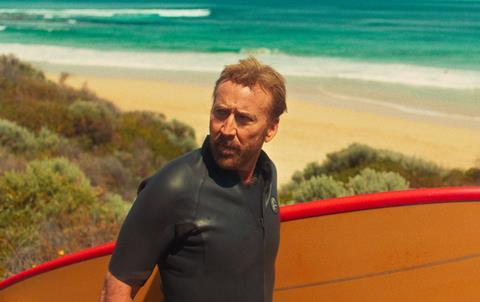
Lorcan Finnegan’s psychological thriller The Surfer, an Ireland-Australia co-production that premieres in Midnight Screenings, had very specific location requirements. It needed a beach that would attract serious surfers, a car park overlooking the water and highly desirable houses dotting the hills behind — preferably all in one location.
The drama kicks off when a man (Nicolas Cage), only just returned to Australia to buy back his family home after building a life in the US, is humiliated in front of his teenage son by a gang of local surfers who claim ownership of the secluded beach of his childhood. The conflict escalates and his sense of self deteriorates.
Finnegan and screenwriter Thomas Martin are both Irish, but the story was always set in Australia, where Martin had spent some time. The project was developed with Tea Shop Productions in the UK, then set up as an Australia-Ireland co-production, between Finnegan’s Lovely Productions and Melbourne-based Arenamedia; US outfit Gramecy Park Media contributed to the financing. Preparation and production took place entirely in Australia, with post-production in Ireland. The latter element allowed the production to access Ireland’s Section 481 incentive.
Australia has tens of thousands of kilometres of coastline and the east coast was considered, but the focus quickly turned to Western Australia. The state has spectacular coastal scenery, much of it isolated and largely unseen on the big screen.
Western Australia was familiar territory to Arenamedia, having made Blueback and Sweet As in the region and, in 2019, set up a Perth office run by James Grandison, one of The Surfer’s producers. “Screenwest [Western Australia’s screen funding and development organisation] was very excited by the project, immediately contributed images and ideas, and helped us put together a physical location scout,” says Grandison. The search took in coastal towns from Kalbarri to Augusta, which are about 900 kilometres apart, and metropolitan options. But Grandison is a surfer himself and always saw the film in Western Australia’s picturesque southwest, a holiday destination with many surf breaks within easy reach of each other. The town of Yallingup was an early frontrunner.
“A film called The Surfer has to have amazing surf and coastline,” he explains. “When the director set foot in the car park there he said, ‘This is great’. Then, when he went down onto the beach, he said, ‘This is it’.
“There are amazing rock formations,” Grandison continues. “You can see half a dozen surf breaks from the car park, and when you look back towards the green hills from the beach, the houses set back in the bush make you think, ‘I want to live there’. It all feels very natural and clean.”
Local incentives
Screenwest and the Western Australian government helped with financing via their then one-year-old Production Attraction Incentive, a discretionary grant for footloose national and international projects. The base rate is 10% of Western Australia expenditure, which must be at least $2.3m (a$3.5m).
As an official co-production with Arenamedia sister company CinemaPlus and Madman Entertainment as local distributors, The Surfer had automatic access to Australia’s producer offset, a federal tax rebate worth up to 40% of Australian expenditure, payable on completion.
The finance plan also contains sales advances, private equity and Irish financial incentives.
Much consultation led up to locking in the five-week shoot for October-November 2023. Parties included the City of Busselton and the parks and wildlife service of the Department of Biodiversity, Conservation and Attractions, residents, environmental and Indigenous groups, and emergency services. Approval was sought to close one of two beachside car parks and to build two small sets: a toilet block in the car park and an open-walled wooden structure on the previously bare beach. Small all-terrain vehicles met the challenge of taking construction materials in and out. The film was predominantly an exterior shoot.
Matching the water across changing tides and wind was a challenge but, as expected, blue skies prevailed. The film’s first assistant director, production manager, safety supervisor and stills photographer all live in the region, but most of the 70 cast and crew came from elsewhere, with a number of the lead actors being from the east coast.
“Our approach was to be respectful of the environment,” says Grandison. “Complaints were minor, and we heard and addressed all concerns. We engaged local people who knew the beach to help with planning. It took hard work but it went well. We were actively welcomed. People wanted us to be there.”

























No comments yet